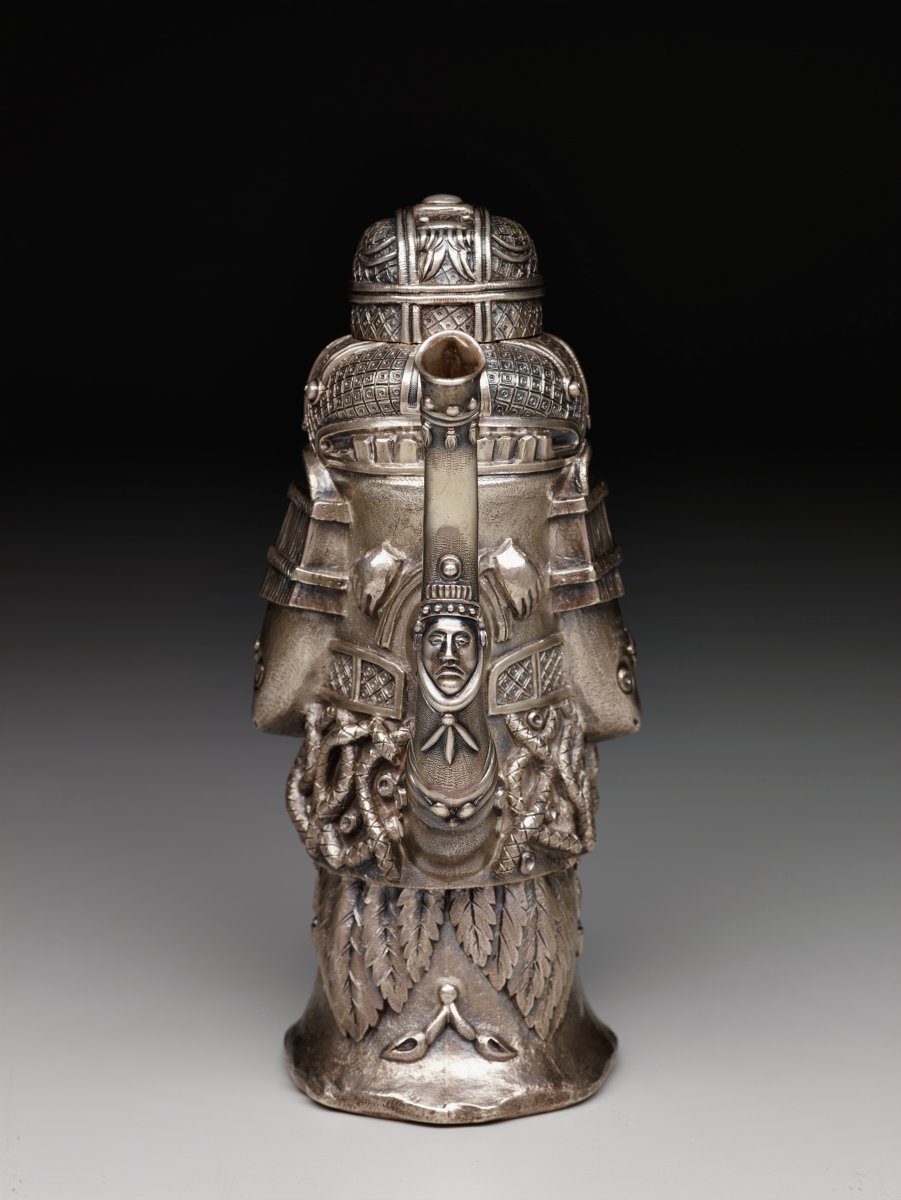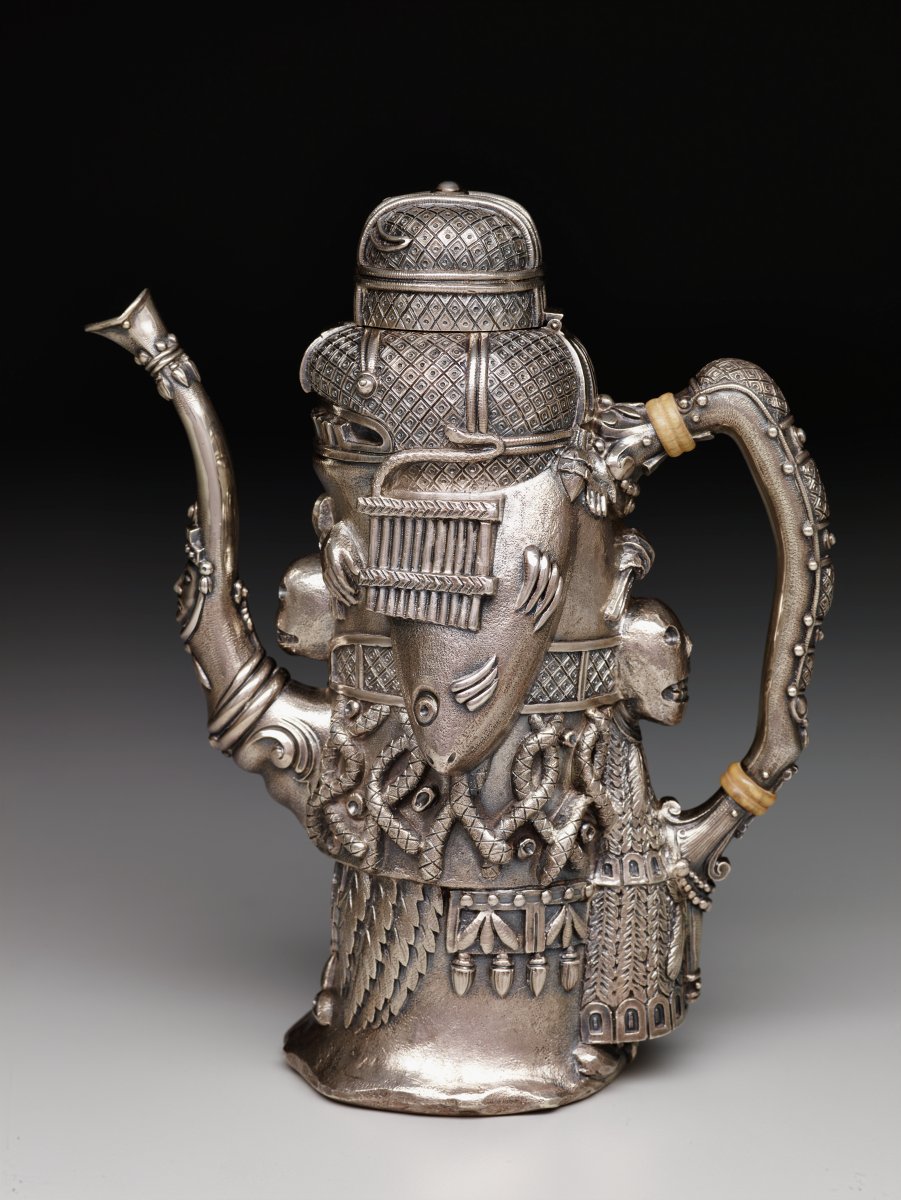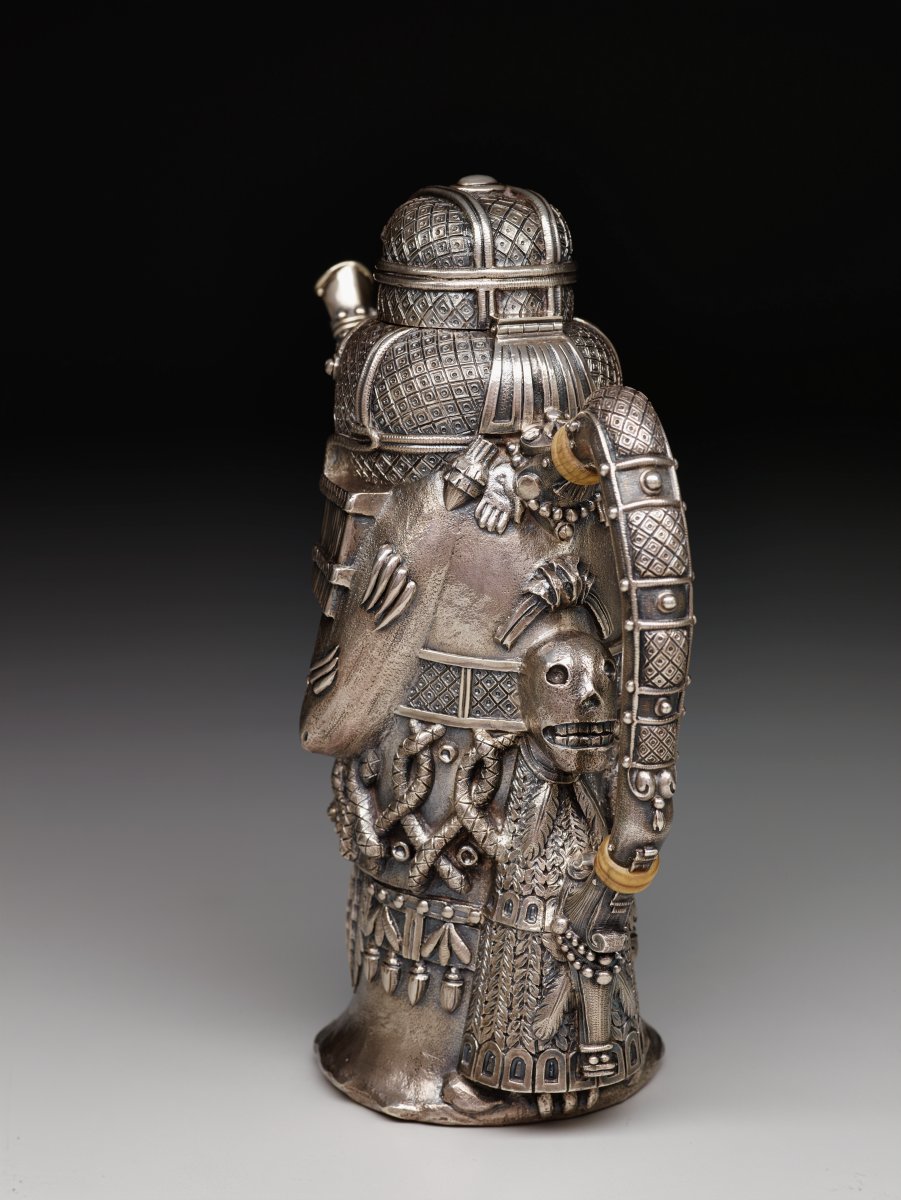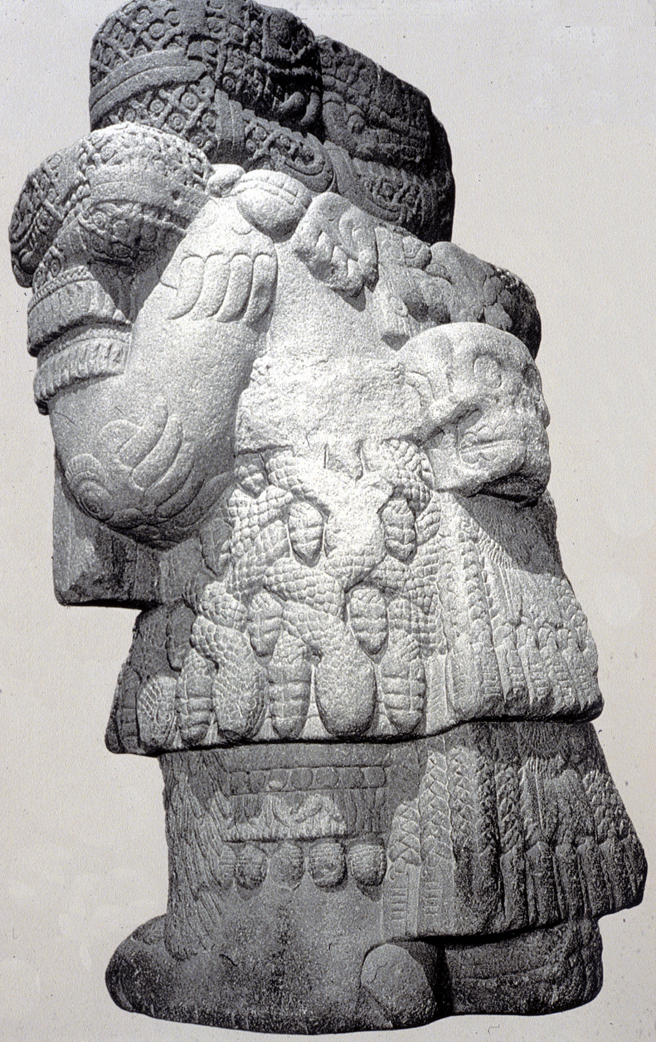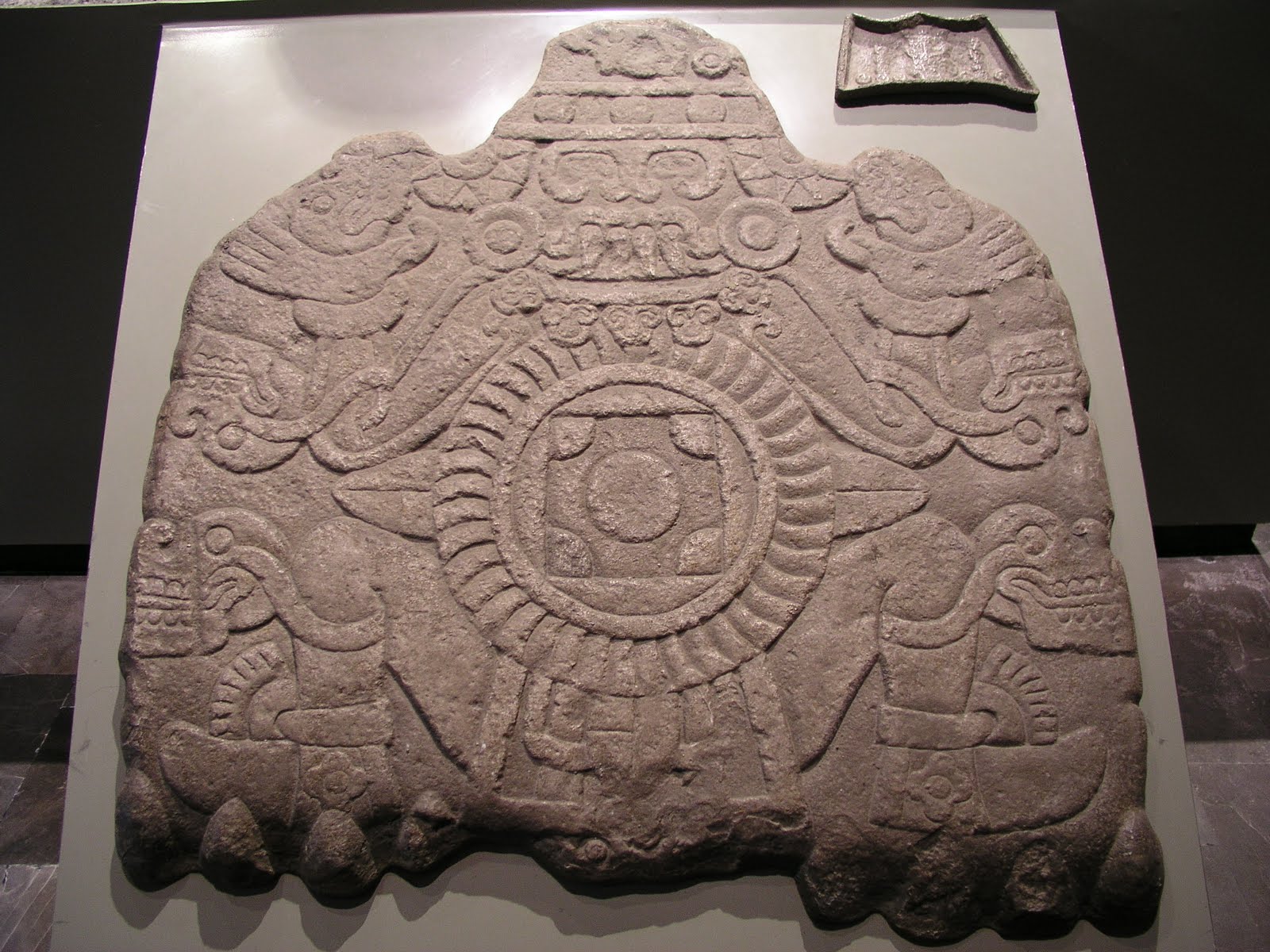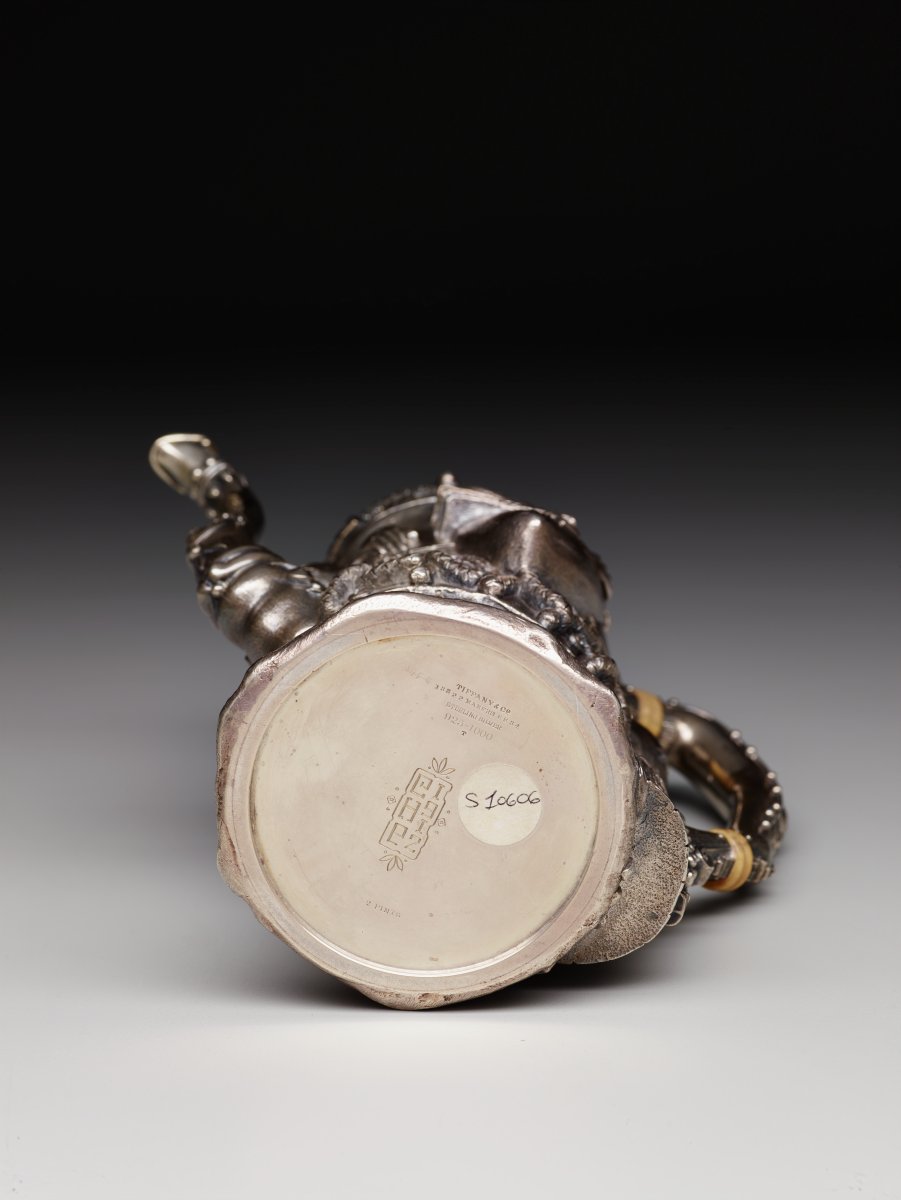In 1897, William Randolph Hearst, an American businessman and newspaper publisher, commissioned an "Aztec" tête-à-tête coffee service for his formal dinnerware use.1 His action of doing so epitomized the popularity of objects in the ''Aztec'' style in the late 19th century. During this century of increased world's fairs, expositions, and international communication, Tiffany & Co. began the production of "Aztec''-style silver objects with the commission of a Teocali centerpiece for the Aztec Club, a military society established during the Mexican-American War, in 1891.2 Informed by public—and especially elite—interest in ancient civilizations, they designed and displayed a second example of an "Aztec" style silver object, a platter of Aztec Calendar Stone, at the 1893 World's Columbian Exposition in Chicago, which was later purchased by William Randolph Hearst.3 This purchase led to Hearst's personal commission of an entire "Aztec"-style coffee service, consisting of a coffee pot, sugar bowl, tongs, and milk pitcher. The entire set was designed by the head of silver design of Tiffany & Co., John T. Curran, who was responsible for much of the magnificent silverwares in Tiffany’s display at the 1893 Chicago Exposition.4 Among these, the coffee pot imitating the Coatlicue statue is the focus of this essay. Building on Samantha Robinson's pathbreaking work in identifying the iconography and interpreting the materiality of silver, this essay will focus in particular on the transformation, rescaling, and embodied use of the Coatlicue monolith as a prototype for the coffee pot among this coffee service set. The discussion of the distortion and adaptation of these features of the original statue will hopefully shed new light on how the coffee pot played its role as a bourgeois object in the late nineteenth century.
John T. Curran, "Aztec" tête-à-tête coffee pot for Tiffany & Co. (1897)
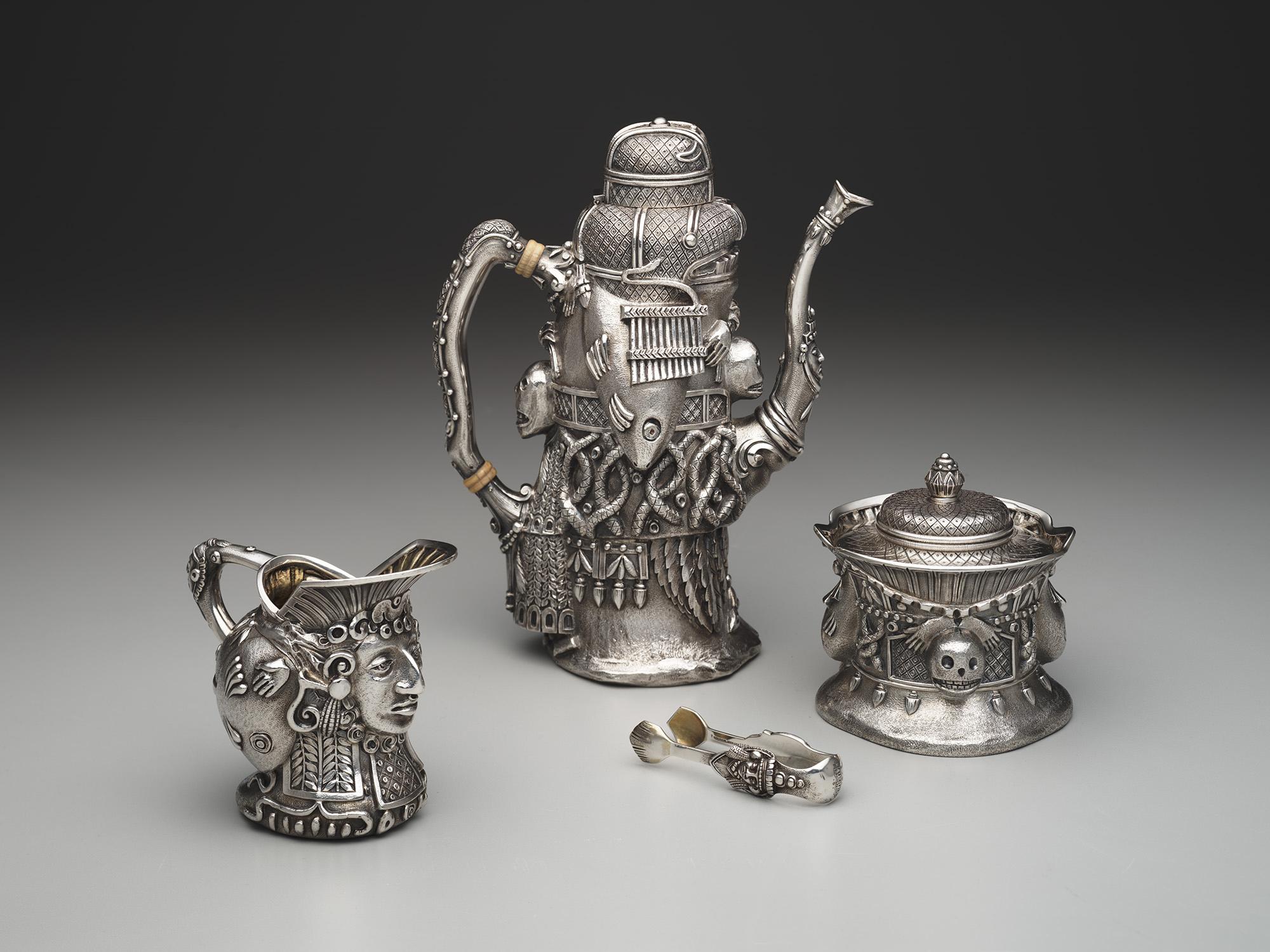
John T. Curran, "Aztec" tête-à-tête coffee service, designed for Tiffany & Co., c. 1897, silver and ivory, size of Coatlicue coffee pot = 9 1/2 × 7 1/2 × 4 1/4 in. (24.13 × 19.05 × 10.8 cm). Dallas Museum of Art 2007.64.1 [Link to source]
This coffee pot retains many elements of the original statue, while also undergoing significant changes in form. When viewed from the front, the original symmetrical form is retained, but the human shape of the original statue is no longer discernible in the coffee pot. As noted by Robinson, the coffee pot omits the breasts which are the primary indicator of the human body of Coatlicue.5 The snake-headed hands have been replaced with two fishes that may be the misinterpretation of the nineteenth-century audience of this monolith, and the feet are no longer present but instead replaced with a solid, bulky base.6 While the serpent-skirt, from which Coatlicue received her name, is still present, it no longer resembles a skirt of a body but has become a decorative element of the vessel. The bodiliness of the artifact is now only decipherable in an upright position, though it no longer resembles a human body.
In addition to the changes made to its original human form, the other zoomorphic aspects have also been lost and altered. The double-serpent head has been transformed into two creatures stacked vertically, one being a smaller lid, the other a part of the body of the vessel. The upper lid portion includes two small beads that mimic snake eyes, while the lower segment imitates another snake or animal with larger eyes. The snake skin's regularly protruding texture is transformed into a flat and abstract grid pattern popular among decorative arts, increasing its ornamentality. The decapitation line is modified into the lower animal's teeth. The Coatlicue's duality is transformed into a hierarchical pairing, abandoning a harmonious duality of the snake heads, but exhibiting different sizes, forms, and functions. Such design makes the opening of this lid not a recurring enactment of the decapitation, but more akin to taking off a hat.
The loss of a human form and the castration of the duality that this statue once represented reinforces its "objecthood," that it is no longer a statue full of idolatrous connotations, but a utilitarian object used in daily life. Although there is a head emerging from the handle, it is decorative rather than connoting a full body. In this way, we could say that this object tries not to evoke any sense of corporeality that might resonate with the viewer or user. The tendency to de-subjectify alienates this object from real people and creates a transcendence that could, to some extent, negate the previous negative European sentiments towards the Coatlicue as an anthropomorphic deity. The skulls on the belt, with two smiling faces, are retained but hidden behind the handle and the spout. Only when viewed at an angle could the full face of the skull be seen. The retention of the skull facilitated the recognition of this coffee pot and allowed people familiar with this statue to associate it with the Pre-Columbian world. Nevertheless, the partially hidden skulls softened the persistent connotations of human sacrifice that haunted Coatlicue and all Pre-Columbian art in the European imagination, reducing its sense of violence and making it serviceable, tame, and luxurious.
Moreover, taken as a whole, a significant change from the Coatlicue statue to this coffee pot is its scale. With a height of 2.52m (8.3ft), the Coatlicue statue towers over its viewers and can only be fully seen by looking up. The coffee pot, on the contrary, is a small object that can be handled intimately and viewed from different perspectives. The transformation from a gigantic work to a miniature re-creates the object and its social space: it is no longer statically engaged with the viewers surrounding it, but displayed on the dining table, seen as a whole by multiple eyes, used as a container, and frequently touched by hand. The embodied engagement with each is absolutely distinctive: the original sculpture subordinates the viewer to its presence, while the coffee pot is subordinated by the viewer. The transformation of scale also sets this little "Coatlicue" in motion. Its role as a container changes its nature, making it penetrable and vulnerable. As Robinson has demonstrated, this coffee service was used at formal dinners in the Hearst home.7 Engagement with it was therefore multisensory, no longer dominated by the visual, but also involving the tactility of handling, the aromas and tastes of the beverages contained within, and even the aurality of the sounds produced by its interactions with the table and other dinnerware. Such scaled re-creations, as Andrew Hamilton has argued, are intimately related to changes in meaning, from collective and religious to individual and private.8 Echoing the Aztec platter that Hearst bought from Chicago Exposition four years previously, this set of coffee service was placed in the conversation with similarly re-scaled imagery from the Aztec Calendar Stone. Their joint appearance as dinnerware in the Hearst house exhibited the Anglo-American’s capability of possessing and manipulating icons that stood in for an entire civilization.
Coatlicue was specifically chosen for this design, perhaps in part because of its fame as one of the most celebrated and well-known works of the Pre-Columbian world in the 19th century, and in part because Coatlicue's multi-layered details satisfied the bourgeois need to present and display their taste, class, and wealth. The choice ultimately lies in its essential tension of being both decoration and representation. Its role as dinnerware is primarily decorative, calling for an "immediate appeal to the senses;"9 while this coffee pot, in reference to the original Coatlicue statue, is also representational. On the one hand, the ornamentality of this coffee pot is manifested by its exaggeration with details. The outer surface is decorated with various elements of Coatlicue, leaving only the handle and the inside of the spout blank. The richly ornamented surface would immediately grab the viewer's attention and evoke sentiments such as astonishment. On the other hand, when Hearst commissioned this object, it was the culmination of a period when Pre-Columbian Mesoamerican works and architectures were seen as America's lost past, also related to the bolstering of America's own national self-confidence.10 Under this context, especially related to the fervor of collecting Pre-Columbian objects in the United States, the possibility for Hearst's guests to recognize the prototype of this representation put his taste and knowledge on display. The tensions between blank and detail, between representation and decoration, are also manifested in the adapted relationship between visibility and invisibility. The carved underside depicting Tlaltecuhtli is not considered for the coffee pot, instead it is replaced by a silver underside engraved with information about the maker, company, and storage labels. The unseen divine is thus superseded by the market, bourgeois taste, and ultimately the museum setting as it is placed now.
In Susan Stewart’s book, On Longing, she states that "the transcendence presented by the miniature is...a transcendence which erases the productive possibilities of understanding through time. Its locus is thereby nostalgic."11 Although the miniaturization of Coatlicue is not an exact replica, but presents multiple distortions and alterations, this coffee pot attempted to reduce this huge statue into a small object that could be tamed. In this sense, Coatlicue was perceived as an inert object from the irrecoverable past that could be controlled, used, and bridled. Its original human form was demolished, and the "monstrous" quality that had haunted Western discourse surrounding the Coatlicue statue during the 19th century was replaced by a softened version that made it suitable for everyday use, but at the same time demonstrated the exotic taste and erudition of Hearst, who was able to commission such a unique Pre-Columbian-inspired work and make it tameable at home. Ultimately, on the one hand, this exoticism of a past culture exhibited his nostalgic sentiment, but on the other hand, the nostalgia implies the inertness of the past, that was only utilized as a manifestation for late-19th-to-early-20th-century bourgeois American taste.
-----------------------------------------------------------------------------
1. Samantha Robinson, "Assembling American Antiquity: The Iconography and Materiality of Tiffany & Company 'Aztec' Style Silver" (M.A. Thesis, Southern Methodist University, 2014), 66.↩
2. Robinson, 32.↩
3. Robinson, 37, 42.↩
4. John Loring, Magnificent Tiffany Silver (Abrams, 2001), 184.↩
5. Robinson, 46.↩
6. Robinson, 48.↩
7. Robinson, 66.↩
8. Andrew James Hamilton, Scale and the Incas (Princeton University Press, 2018), 30.↩
9. Jonathan Hay, Sensuous Surfaces: The Decorative Object in Early Modern China (Reaktion Books, 2010), 77.↩
10. R. Tripp Evans, Romancing the Maya: Mexican Antiquity in the American Imagination, 1820-1915 (University of Texas Press, 2004), 5 & 162.↩
11. Susan Stewart, On Longing: Narratives of the Miniature, the Gigantic, the Souvenir, the Collection (Duke University Press, 1993), 60.↩
